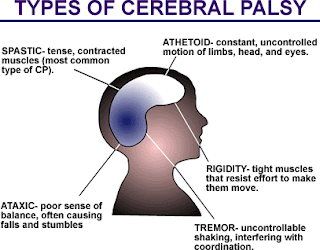Eccentric topic of the Week, Neuropathology
Question 9 Answer:
The correct answer is C, before 2 years.
Cerebral palsy (CP) is a group of disorders characterized by loss of movement or loss of other nerve functions. Cerebral palsy is the
result of injury to the brain during early development (before age 2). Hypoxia is the main cause of injury to the brain in CP.
Extent of motor involvement varies greatly, from a slight limp to profound paralysis, spasticity or speech problems, as well as associated disorders of learning problems, sensory deficits, and convulsive and behavioral disturbances of organic origin.
There are four main types:
Ataxic - voluntary movements are jerky; balance is lost.
Athetoid - continual muscle movements prevent or severely interfere with voluntary movements.
Hypotonic - muscles are limp, cannot contract.
Spastic - muscles are stiff; some body parts are paralyzed.
Extent of motor involvement varies greatly, from a slight limp to profound paralysis, spasticity or speech problems, as well as associated disorders of learning problems, sensory deficits, and convulsive and behavioral disturbances of organic origin.
There are four main types:
Ataxic - voluntary movements are jerky; balance is lost.
Athetoid - continual muscle movements prevent or severely interfere with voluntary movements.
Hypotonic - muscles are limp, cannot contract.
Spastic - muscles are stiff; some body parts are paralyzed.


No comments:
Post a Comment